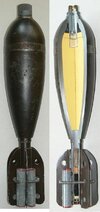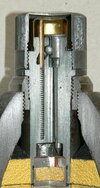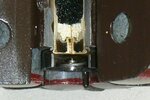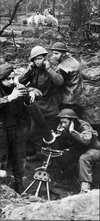pzgr40
Well-Known Member
Cutaway model of a WW2 Brittish “Bomb ML 4.2 in. Streamline HE” (106,7 mm) high explosive mortar bomb, as used in the Ordnace S.B. 4.2” mortar. Originally , the 4.2” mortar was designed in 1941 and was meant as a chemical mortar, soon however priority was given to HE shells, as a result of experience gained in North Africa. The HE round was meant to have a range of 4400 yds (4000 mtrs), however, the first type -unstreamlined bomb- only had a maximum range of 3300 yds (3000 mtrs). The later -streamlined- version (cutaway model shown here) had a max. range of 4000 yds (3640 mtrs).
The bomb had a Vo. of 223 mtrs/sec (731 ft/sec) and a weight of 9,08 kg (20 Lb).
The length of the complete round is 518mm, with the safety cap removed the length is 513mm.
The filling of the bomb was a mixture of Ammoniumnitrate and TNT (Amatol) 80/20 or 70/30 either pure TNT or a mixture of TNT/RDX.
A cartboard packed Tetryl booster is placed just below the fuze.
A layer of bitumus kit (black) is moulded between the fuze and the main charce to enshure moisture free storage.
The propelling catridge has a charge of 9,3 grams ballistite. An interesting item on the propelling cartridge is the ring pressed over the rim of the shellcase. It contains a brass plate to which a firing pin is connected. This means every bomb has it’s own firing pin, the weapon has does not need one.
Six incremental charges containing 22,7 grams of powder can be added to the tailfins to in- or decrease range.
The fuze used on this bomb is the fuze DA 152 (Direct Action). The body of the fuze is made of cast zinc. It contains the firing pin, the sping loaded rotation shutter (housing the firing cap), The detent and the detent spring and the detent ball. The lower part houses the magazine, containing a C.E. pellet. On top a thin brass safety cap is crimped .
Functioning of the Fuze:
Before firing, the zinc transport cap is screwed off – as the text on top says: remove before firing- , exposing the brass safety cap.
Upon firing, inertia sets back the brass detent pin –riding it’s spring-, enabeling the detent ball to roll down the channel. After the acceleration has stopped the detent pin moves upward again untill it is blocked by the ball (see fuze picture: after firing). The firing pin is forced up by the firing pin spring, thereby releasing the spring loaded rotation shutter that is held in off line position by the point of the firing pin in the safe position. The shutter now rotates under the firing pin. On impact the brass cap is crushed inward , forcing the firing pin into the firing cap, which ignites the C.E. pellet magazine. This will ignite the booster and the main charge.
Regards DJH
The bomb had a Vo. of 223 mtrs/sec (731 ft/sec) and a weight of 9,08 kg (20 Lb).
The length of the complete round is 518mm, with the safety cap removed the length is 513mm.
The filling of the bomb was a mixture of Ammoniumnitrate and TNT (Amatol) 80/20 or 70/30 either pure TNT or a mixture of TNT/RDX.
A cartboard packed Tetryl booster is placed just below the fuze.
A layer of bitumus kit (black) is moulded between the fuze and the main charce to enshure moisture free storage.
The propelling catridge has a charge of 9,3 grams ballistite. An interesting item on the propelling cartridge is the ring pressed over the rim of the shellcase. It contains a brass plate to which a firing pin is connected. This means every bomb has it’s own firing pin, the weapon has does not need one.
Six incremental charges containing 22,7 grams of powder can be added to the tailfins to in- or decrease range.
The fuze used on this bomb is the fuze DA 152 (Direct Action). The body of the fuze is made of cast zinc. It contains the firing pin, the sping loaded rotation shutter (housing the firing cap), The detent and the detent spring and the detent ball. The lower part houses the magazine, containing a C.E. pellet. On top a thin brass safety cap is crimped .
Functioning of the Fuze:
Before firing, the zinc transport cap is screwed off – as the text on top says: remove before firing- , exposing the brass safety cap.
Upon firing, inertia sets back the brass detent pin –riding it’s spring-, enabeling the detent ball to roll down the channel. After the acceleration has stopped the detent pin moves upward again untill it is blocked by the ball (see fuze picture: after firing). The firing pin is forced up by the firing pin spring, thereby releasing the spring loaded rotation shutter that is held in off line position by the point of the firing pin in the safe position. The shutter now rotates under the firing pin. On impact the brass cap is crushed inward , forcing the firing pin into the firing cap, which ignites the C.E. pellet magazine. This will ignite the booster and the main charge.
Regards DJH
Attachments
Last edited:




